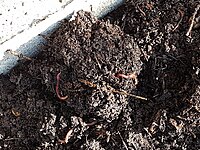
Photo from wikipedia
Variation in community diversity along ecological gradients has been the main focus in recent biodiversity studies. Among multiple interacting resource gradients, the altitude gradient may be a decisive factor determining… Click to show full abstract
Variation in community diversity along ecological gradients has been the main focus in recent biodiversity studies. Among multiple interacting resource gradients, the altitude gradient may be a decisive factor determining spatial patterns of community diversity. The Manas River Basin is a typical mountain⁃oasis⁃desert ecosystem(MODS) in the inland arid areas of Northwest China. Soil mites have been used as an important bioindicator of soil ecosystems. In order to provide a scientific basis for the biological assessment of human activities on soil environmental quality in mountain⁃oasis⁃desert ecosystems, investigations were conducted on the community diversity and seasonal dynamics of soil mites at different vertical zonal habitats in the Manas River Basin using field sampling and improved Tullgren methods. In addition, further comparative analyses of the ecological distribution characteristics of soil mite communities in that area were performed. The results showed that 32308 soil mites were captured and classified into four suborders, 86 families, and 140 genera. Among them, Ceratozetes and Oribatula were dominant groups and accounted for 10. 14% and 11. 18% of total individuals collected, respectively; Epilohmannia, Trhypochthonius, and Zygoribatula, and 18 genera were common groups, and accounted for 55. 89%. Cosmochthonius, Eremaeus, and Allothrombium, and the other 120 genera belonged to rare groups, and only accounted for 22. 79% of total collections. The numbers of individuals and groups of soil mite communities differed significantly in different vertical zonal habitats (P<0.05), the number of individuals, in the 0—5 cm vertical layer of the soil profile. With increasing depth of soil layers, the numbers of individual and groups of soil mites decreased gradually (P< 0. 01 ). There were significant differences in the seasonal variation in the composition and individuals of soil mite htt p:/ /w ww .ec olo gic a.c n http: / / www.ecologica.cn communities (P<0.05). The sequence of seasonal change of individual numbers of soil mites was September > April > July > November. There were significant differences in diversity indices for soil mite communities between the 12 different habitats ( P < 0. 05), the Shannon⁃Wiener diversity index (H) in coniferous forest > mountain farmland > mountain shrubbery > shelter forest deciduous forest > vegetable field > mountain steppe > vineyard > grassland > plain farmland > shrubbery > desert, while Margalef (M) richness index for coniferous forest > shelter forest > deciduous forest > vegetable field > shrubbery > grassland > mountain farmland > mountain shrubbery > pain farmland > mountain steppe > vineyards > desert. The similarity coefficient between soil mite communities in 12 different habitats was moderately dissimilar. Research results showed that community structure and diversity of soil mites in different habitats have obvious characteristics of habitats and seasonal variation in that MODS.
Journal Title: Acta Ecologica Sinica
Year Published: 2017
Link to full text (if available)
Share on Social Media: Sign Up to like & get
recommendations!